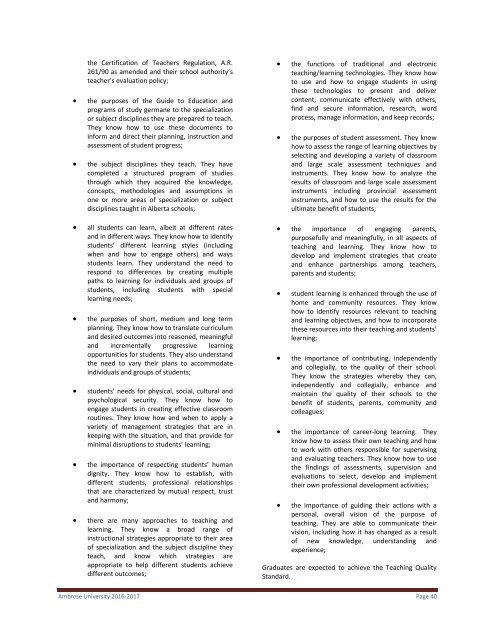undergraduate
2016-2017_undergraduate
2016-2017_undergraduate
You also want an ePaper? Increase the reach of your titles
YUMPU automatically turns print PDFs into web optimized ePapers that Google loves.
the Certification of Teachers Regulation, A.R.<br />
261/90 as amended and their school authority’s<br />
teacher’s evaluation policy;<br />
the purposes of the Guide to Education and<br />
programs of study germane to the specialization<br />
or subject disciplines they are prepared to teach.<br />
They know how to use these documents to<br />
inform and direct their planning, instruction and<br />
assessment of student progress;<br />
the subject disciplines they teach. They have<br />
completed a structured program of studies<br />
through which they acquired the knowledge,<br />
concepts, methodologies and assumptions in<br />
one or more areas of specialization or subject<br />
disciplines taught in Alberta schools;<br />
<br />
<br />
the functions of traditional and electronic<br />
teaching/learning technologies. They know how<br />
to use and how to engage students in using<br />
these technologies to present and deliver<br />
content, communicate effectively with others,<br />
find and secure information, research, word<br />
process, manage information, and keep records;<br />
the purposes of student assessment. They know<br />
how to assess the range of learning objectives by<br />
selecting and developing a variety of classroom<br />
and large scale assessment techniques and<br />
instruments. They know how to analyze the<br />
results of classroom and large scale assessment<br />
instruments including provincial assessment<br />
instruments, and how to use the results for the<br />
ultimate benefit of students;<br />
<br />
<br />
<br />
<br />
<br />
all students can learn, albeit at different rates<br />
and in different ways. They know how to identify<br />
students’ different learning styles (including<br />
when and how to engage others) and ways<br />
students learn. They understand the need to<br />
respond to differences by creating multiple<br />
paths to learning for individuals and groups of<br />
students, including students with special<br />
learning needs;<br />
the purposes of short, medium and long term<br />
planning. They know how to translate curriculum<br />
and desired outcomes into reasoned, meaningful<br />
and incrementally progressive learning<br />
opportunities for students. They also understand<br />
the need to vary their plans to accommodate<br />
individuals and groups of students;<br />
students’ needs for physical, social, cultural and<br />
psychological security. They know how to<br />
engage students in creating effective classroom<br />
routines. They know how and when to apply a<br />
variety of management strategies that are in<br />
keeping with the situation, and that provide for<br />
minimal disruptions to students’ learning;<br />
the importance of respecting students’ human<br />
dignity. They know how to establish, with<br />
different students, professional relationships<br />
that are characterized by mutual respect, trust<br />
and harmony;<br />
there are many approaches to teaching and<br />
learning. They know a broad range of<br />
instructional strategies appropriate to their area<br />
of specialization and the subject discipline they<br />
teach, and know which strategies are<br />
appropriate to help different students achieve<br />
different outcomes;<br />
the importance of engaging parents,<br />
purposefully and meaningfully, in all aspects of<br />
teaching and learning. They know how to<br />
develop and implement strategies that create<br />
and enhance partnerships among teachers,<br />
parents and students;<br />
<br />
<br />
<br />
<br />
student learning is enhanced through the use of<br />
home and community resources. They know<br />
how to identify resources relevant to teaching<br />
and learning objectives, and how to incorporate<br />
these resources into their teaching and students’<br />
learning;<br />
the importance of contributing, independently<br />
and collegially, to the quality of their school.<br />
They know the strategies whereby they can,<br />
independently and collegially, enhance and<br />
maintain the quality of their schools to the<br />
benefit of students, parents, community and<br />
colleagues;<br />
the importance of career-long learning. They<br />
know how to assess their own teaching and how<br />
to work with others responsible for supervising<br />
and evaluating teachers. They know how to use<br />
the findings of assessments, supervision and<br />
evaluations to select, develop and implement<br />
their own professional development activities;<br />
the importance of guiding their actions with a<br />
personal, overall vision of the purpose of<br />
teaching. They are able to communicate their<br />
vision, including how it has changed as a result<br />
of new knowledge, understanding and<br />
experience;<br />
Graduates are expected to achieve the Teaching Quality<br />
Standard.<br />
Ambrose University 2016-2017 Page 40


